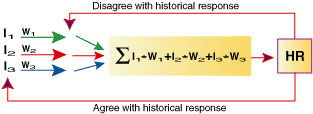ARTIFICIAL INTELLIGENCE
Computers On The Brain
Neural Networks
by Wolf von Rönik
Think neural networks are too difficult a concept to learn? They're not. Take a look.
In a broad sense, neural nets are computer models that attempt to mimic the "wetware" or actual physiological structure and functioning of the brain (which is outlined in the sidebar, "Neurons"). These models use the following analogies:
In the simple model displayed in Figure 1, I1, I2, and I3 represent inputs. Moving down, each input reaches a weight (synapse) labeled W1, W2, and W3 where input and corresponding weight are multiplied. This new information is conducted (dendrite) as input to the node (soma). Inside the node, the input-weight products are summed. This sum is then sent as output along the single output (axon) arrow on the right to be compared with a desired historical response. If the output and the historical response agree (that is, a threshold is reached), you follow the lower arrow and the model receives new input. If they don't agree, you return to the weights via the top arrow, revalue the weights, and repeat the process until the output and desired historical response agree.
This deceptively simple model allows a neural net to do something that is impossible for an expert system: The net can "learn" to draw conclusions from input of data rather than need to be told what conclusions to draw in response to input. This amazing attribute is the result of the net's ability to learn by altering its weights until it matches input with desired historical response to a high degree of accuracy. In a neural net, the weights are analogous to memory.

FIGURE 1: A SIMPLE NEURAL NET MODEL. The inputs are weighted and multiplied. The input-weight products are summed and sent as output (historical response). If the output and historical response agree, then the model receives new output. If they don't agree, the weights are reevaluated and the process is repeated until the output and desired historical response agree.
...Continued in the April 2003 issue of Technical Analysis of STOCKS & COMMODITIES
Excerpted from an article originally published in the April 2003 issue of Technical Analysis of STOCKS & COMMODITIES magazine. All rights reserved. © Copyright 2003, Technical Analysis, Inc.
Return to April 2003 Contents